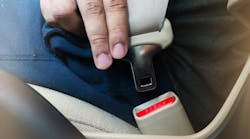The recent report on the alarming increase in traffic fatalities this year from the National Highway Safety Administration identified speeding and failure to use a seat belt as the top two risky behaviors among car and truck drivers. It is simple and accurate for fleet managers to advise their drivers to slow down and buckle up.
We all learned this “back-to-basics” message. It sits right up there with the message from your mother to wash your hands before dinner or your father teaching you to say, “Yes, sir” and “Yes, ma’am.”
We learn the basics of a task because they form the foundation for success—in this case, for safety on the highway. “Slow down” and “Buckle up” fit well with “keep your eyes on the road.” We easily remember these simple phrases. If we follow them, everyone benefits.
Over time, though, drivers can come to think that experience and ability compensate for deviation from basic safety practices. Unfortunately, that attitude can rise in parallel with increases in experience and ability, as a career driving trucks may provide. It may be time to reinforce the old “back-to-basics” messages with a reminder of why they work.
Speeding
High school physics taught us Newton’s Second Law of Motion: force equals mass times acceleration. So, take care driving a truck, because its mass is great, and at any appreciable rate of acceleration, the force it can apply will be significant. Even if truck drivers do not recall physics, they well understand they are driving a big machine in a world of smaller vehicles.
In our overreliance on experience and ability, we often forget how speed affects perception time, reaction time, and braking distance. Perception time is how long it takes to recognize a hazard ahead—about 1 to 2 seconds for the average alert driver. Reaction time measures how quickly that driver, having perceived the hazard, applies the brakes, which adds about another second. Finally, the braking distance is how far the truck travels with the brakes applied. The sum of these three—perception time, reaction time, and braking distance—equals the truck’s total stopping distance. Increases in speed greatly extend the total stopping distance.
Consider just these two common legal speed limits: At 55 mph, a fully-loaded tractor-semi will have a total stopping distance of 335 ft. Just 10 mph faster, at 65 mph, that total stopping distance balloons to 525 ft. This comparison assumes a truck with good tires and brakes on dry pavement, plus an alert driver. Speeds in excess of these limits compound the distances exponentially. In a world of distracted car drivers, one factor a trucker can control is speed.
Seat belts
Remember the TV commercials featuring the crash test dummies Larry and Vince? No, they couldn’t really talk. But, yes, dummies were used to test the effectiveness of seat belts in crashes. And it’s a good thing the tests were with dummies. Truck drivers who don't use seat belts are 30 times more likely to be ejected from their vehicle during a crash and about 75% of those ejected die from their injuries. One could ask who is the real dummy for not buckling up?
When we get back to basics, we get back to safety.
Steve Vaughn is the vice president of field operations at PrePass Safety Alliance, the provider of PrePass weigh station bypass and toll payment/management services. Vaughn served nearly three decades with the California Highway Patrol and is a past president of the Commercial Vehicle Safety Alliance.



